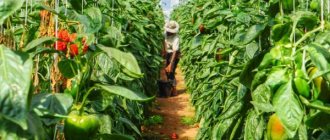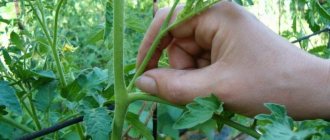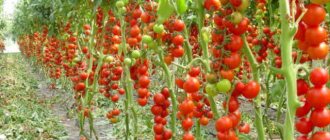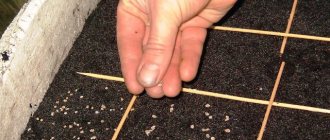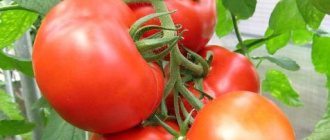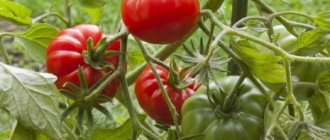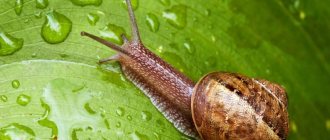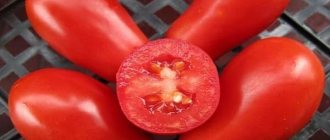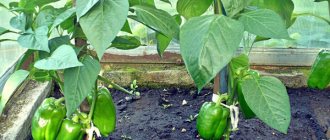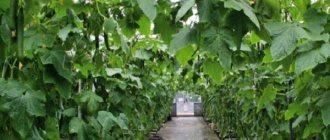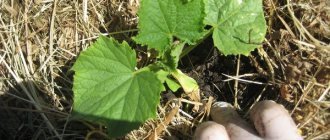How many trunks and stems is it better to form tomatoes in a greenhouse and open ground?
- Gardeners in southern latitudes grow plants such as tomatoes, in addition to other common vegetable crops. The warm climate is ideal for tomatoes: in favorable weather conditions you can get a generous harvest.
- With insufficient lighting and low temperatures, which is typical for northern latitudes, tomatoes grow and develop more slowly.
Low varieties of tomatoes
- It is better to familiarize yourself with the recommendations for forming tomato bushes in a greenhouse in advance. Spring will come very soon and gardening and gardening topics will become relevant.
To grow in a greenhouse, gardeners advise choosing indeterminate varieties and hybrids.
- In greenhouse conditions, indeterminate varieties and hybrids produce a lot of fruit. Tomato bushes of this group continue to grow until the onset of sub-zero temperatures. But such tomato bushes not only grow upward, but also acquire side branches.
- Plants have a feature that gardeners have to constantly struggle with: shoots form on the main trunk. They are usually called stepchildren.
- One or two stepsons grow from the leaf sinuses within a week.
- Overfeeding the bushes can lead to the formation of stepsons not only in the leaf axils, but also in the flower clusters, even on the leaves.
- The gardener will have to struggle for a long time with the appearance of stepsons in order to move freely around the greenhouse. Otherwise, by mid-July the tomatoes will occupy the entire greenhouse space, and by August it will simply be impossible to move around the greenhouse.
How to determine where the stepson is and where the leaf is
- A novice gardener may decide that such a “forest” of tomato shoots is certainly a big harvest. But tomatoes with such lush foliage will experience a lack of nutrition, and the short summer will not be enough for the stepchildren to develop into full-fledged shoots.
- Lack of sunlight and dampness will create real resort conditions for various diseases.
- Plants will be forced to direct energy not to ripening fruits, but to growing greenery and a large number of defective peduncles. But the foliage and flowers of tomatoes are not eaten. Is it worth enjoying the beauty of green tops?
- Therefore, if your plans do not include breeding several generations of Colorado potato beetles during the summer, then the formation of tomato bushes with 1 or 2 trunks is one of the important stages of proper cultivation.
The formation of tomato bushes in a greenhouse is one of the important stages of their rational cultivation
Basic principles
Is it necessary to plant standard varieties of tomatoes? If the description indicates that a procedure is necessary, it must be performed.
Stepsoning
How to correctly step-son:
- leave the main 1 trunk;
- remove the lateral stepsons in the sinuses;
- The stumps are left no more than 2 cm.
The procedure is carried out in the morning. Use gloves. Disinfect scissors with 1% potassium permanganate.
Pinching in open ground is carried out in 1 stem according to the classical scheme.
Topping
The manipulation is performed from morning until 7-8 o'clock. The brush is removed on the main and side trunks. It is important to leave 2 free leaves from the ovary.
Then they lead the bush into 1 stem. The procedure may be necessary at the end of the growing season.
Removing leaves
Remove no more than 1-2 lower leaves weekly. Performed together with stepsoning. The procedure eliminates thickening and serves as a prevention of late blight. This is done very carefully so as not to damage the delicate skin.
How to properly grow single-stem tomatoes?
The most accessible method for beginning gardeners is to leave 1 stem per tomato plant. This method is used on indeterminate tomatoes: all side branches are removed. After this, only the main trunk remains. Before the onset of August, 5-6 bunches of fruit have time to ripen on a tomato bush.
- The method of forming a tomato bush into one trunk is recommended for beginning gardeners. Tomato fruits of indeterminate varieties can be obtained throughout the summer.
- After the appearance of the 10th or 11th leaf, a flower cluster grows; further tomato flowers will appear after 3 leaves.
- The packet of tomato seeds usually indicates how the stem will be formed. In the absence of such a mark, it must be indicated that the selected variety belongs to the group of indeterminate varieties.
The packet of tomato seeds usually indicates how the stem will be formed.
When do stepsons appear on a tomato plant?
- The tops growing on the sides of the main trunk, which are more correctly called stepchildren, appear after the first flower cluster has blossomed.
- Her stepson is growing right under her. The first stepson on the trunk is durable and thick, so experienced gardeners do not tear it off, but pinch it after the flower cluster appears.
- Pinching is done in such a way that two leaves remain above the brush. This simple but mandatory manipulation will allow the juice to circulate fully.
- Further cultivation, in addition to watering and fertilizing, also involves breaking out the shoots once a week.
Pruning side shoots
With the onset of August, it is worth paying attention again to the formation of the tomato bush:
- During this period, it is necessary to pinch the tops of the tomatoes.
- Flowers and unripe fruits, the size of which does not exceed the size of a hazelnut, are removed.
- If the weather remains warm enough in September, then you don’t have to pinch the tomato plants or pick off the small flower clusters.
Forming a tomato bush into 1 stem
Should I cut off or leave the lower leaves?
- The foliage below breaks off when the fruits are fully formed and begin to ripen.
- Start picking off leaves 1-3 pieces at a time. once a week is needed in the last days of May - at the beginning of June.
- If you pick off more than 3 leaves at a time, the plant will be severely stressed.
- This unfavorable period for the tomato bush will affect growth (it will be delayed), and partial loss of formed fruits is also possible.
Growing tomatoes with one stem
The process of bush formation: rules and features
Not all tomatoes in a greenhouse made of polycarbonate, film, glass or cultivated on ordinary beds are formed in the same way. There are special schemes recommended for use depending on the type of bush.
If you trim plants in accordance with them, this will give them the opportunity to develop most correctly and show all the breeding potential inherent in them.
Pinching is best done in the morning, in sunny and warm weather: by the evening the damaged areas will have time to dry out. To remove stepchildren, use a sharp knife, scissors, or simply pinch them off with your hands. They do not cut them off at the root, but leave small stumps 1 cm high. This will not allow new stepsons to grow again in this place.
Indeterminate tomatoes
Plants of this type have unlimited growth; they are usually tall tomatoes and produce the largest yield. They are usually formed into one stem. It is believed that this way nutrients are most evenly distributed throughout all tissues, and the height of the plant is already sufficient to form a decent number of fruits. Therefore, in the process of forming indeterminate tomatoes, absolutely all of their stepsons are removed.
Features of tall tomatoes - the 1st cluster is formed after 10-12 leaves, inflorescences - after 3 leaves. To properly form tomatoes, you need to decide on the number of fruit clusters that will need to be left on the bush:
- 7 inflorescences – for greenhouses;
- 5 – for unpaved ones.
After the plants produce the last cluster, leave 1-2 leaves above it and cut off the top so that the tomatoes no longer set fruits that will not have time to ripen before the onset of cold weather. The lower leaves are also removed; they interfere with air circulation and ventilation of the soil around the bushes; yellowed and withering leaves are also cut off. In addition to pruning, tall tomatoes need to be tied to a support or trellis.
Determinate tomatoes
This type of tomato is characterized by limited growth, they grow only to a certain height (0.8-1.2 m) and lay 3-6 clusters. They appear on plants more often than on indeterminate ones - with an interval of 1-2 leaves, the 1st inflorescence appears after 8-9 leaves. Tomato bushes of this type are formed depending on the growing method (in greenhouses, greenhouses or open ground):
- In 1 or 2 stems, if they grow in open, unprotected ridges. In the first case, all the stepsons are cut out, leaving the top. When forming a tomato into two stems, the first stepson is not removed. The 3-stem pattern is not used on open beds.
- 3 stems if they grow in a greenhouse. This is usually how mid-late varieties are formed. The first 2 stepsons are left on each bush; they are shortened after the first flower cluster is formed on it, leaving 1 leaf above it.
- With the transfer of the growth point to a side shoot. This option is recommended for mid-early varieties and hybrid tomatoes. The formation process looks like this: the first stepson is allowed to grow, and a second shoot should appear on it. On each of them, 2-3 fruit clusters are kept, the tops after them are cut off, leaving 1 leaf above the tomatoes. All other shoots are removed. This technique allows you to avoid topping the main stem and get a few more inflorescences.
The latter scheme is suitable for the formation of determinate tomatoes in winter-spring rotation in heated greenhouses.
How to properly form tomato bushes into 1 stem: diagram, description
The most common way for experienced gardeners to form tomatoes is in one stem. It is used for greenhouse tomatoes or plants that are grown without additional shelter.
Forming tomatoes into one stem:
- The first time the side branches are pinched 10-12 days after planting the seedlings. All side leaves are torn off. After this formation, flowers and tomatoes will grow on the main stem.
- In the last days of August, when many fruits have already formed on the bush, the top breaks off. This will speed up the ripening process of tomatoes.
- Experienced gardeners carry out pinching and pinching tomato bushes in the beds this way: many fruits are formed on one trunk, and no foliage grows on the sides of the stem.
How to create super-determinate tomato varieties
Forming tomatoes into two stems.
Growing indeterminate varieties with two stems is the most acceptable for most regions of the country. The strongest sprout should be left. To do this, a sprout is left under the lower tied brush and allowed to grow, while it is also tied up and after a short time becomes the second main trunk.
The growth of these huge bushes is, of course, restrained, but at the same time a good harvest is obtained in the lower tier. The top of this stepson should end in a brush with ovaries.
If this does not happen, then the stepson must be carefully cut out. On both stems you need to leave five or six clusters with ovaries; if you leave more, the fruits in the greenhouse will not gain weight and will be small. When five or six clusters form and begin to gain weight, you need to cut off the tops so that the bushes direct their energy to growing fruits, and not to growing the stem upward.
This option is suitable if there is little space in the greenhouse, but you need to get a large harvest. This method puts a lot of stress on the tomato bush and therefore one should not forget about fertilizing and timely watering. After all, pinching two stems puts much more stress on the tomato bush.
Therefore, in order for the roots of the bush to absorb a double dose of watering and fertilizer, it must also be increased. Therefore, they dig in a shoot growing from the very bottom of the bush; it will give roots, and the bush will be able to receive twice as much nutrition.
There is another method of forming tomatoes in a greenhouse into two stems. At the time of growing seedlings, you need to remove everything that grows above the first node of leaves. After some time, the tops will emerge from the two lower axils of the sprout. Pinching in this way is carried out at an early stage of growing seedlings and therefore the tomato bush does not experience stress, so high-quality seedlings continue to grow.
Video:
How to properly form tomato bushes into 2 stems: diagram, description
- The method of forming tomato bushes into two trunks can be used for varieties that do not grow very tall.
- These are determinate varieties. A small number of flower clusters are formed at the top of each plant.
- To get a generous harvest, you need to shape the tomato plant so that several trunks remain. After this, a cluster of flowers will grow on each top of the bush and the tomatoes will ripen.
Formation of tomato bushes into 2 stems:
- The shoots do not break off until two leaves appear side by side. The stepson is removed along with the side branches.
- There are a decent number of branches and two trunks left on the trunk. This method is used on open ground plants.
Advantages of forming tomatoes into two stems:
- The ripening period of the crop is shortened
- The number of fruits increases
Methods for forming tomato bushes with 2 or 3 trunks
Why are tomatoes formed?
Tomato bushes are formed mainly to increase yield. Sometimes the goal is to grow one record-breakingly large tomato or to obtain varietal seeds from the first tomato to ripen on the bush. Also, bushes with tomatoes can play a purely decorative role. These varieties include those that grow in the house in flower pots, for example, Chinese multi-colored tomato.
Formation using pinching and pruning is not necessary only in the case when the tomato bushes belong to the standard varieties of super-determined species . They are genetically programmed to stop stem growth after a few clusters of flowers have formed. They usually have few leaves and a strong trunk without shoots, on which bunches of tomatoes ripen. However, the height may vary. There are low-growing varieties for open ground and greenhouses, and tall varieties for greenhouses.
The advantage of determinate types of tomatoes is that they do not require pinching, and low-growing varieties do not need to be tied up or surrounded by a trellis. However, all these species are low-yielding due to stunted growth.
Other varieties of tomatoes, classified as high-yielding, produce a large number of leaves, shoots, and clusters of flowers. Without pinching and pruning, their green mass prevails over the mass of fruits. They require more space and shade neighboring plants. They grow uncontrollably if their development is left to chance. Too high planting density and dense bushes interfere with the ripening of tomatoes and reduce yields.
To increase the yield, after planting, you need to wait until two clusters of flowers bloom on the main trunks of tomatoes in open ground, and three clusters of flowers in a greenhouse or hothouse. After this, cut off the lower leaves and pinch the shoot buds at the internodes so that at least 20 centimeters of the bush below is bare.
Pinching out excess tomato shoots at the internodes
You should cut it off, leaving a “stump” of about 1, but not more than 2 centimeters, which will then dry out and fall off. In this place of the trunk the shoots will no longer grow. This will provide better ventilation, it will be more convenient to water without wetting the leaves, and rot and disease due to fungi or viruses will not develop from wet soil. In greenhouses, where the humidity is always higher than in open beds, this action must be done.
What happens if the tomatoes are not shaped?
To get a decent result, you need to organize proper care for tomatoes. Otherwise, tomato plants, in the absence of sufficient heat and light, simply will not have time to ripen to such a state that the gardener will receive fruits of good quality and in sufficient quantity.
- Unfortunately, even experienced gardeners do not know methods that help to form tomato bushes correctly. According to most gardeners, the main stage is planting the plants, and the number of fruits obtained will depend on the feeding, sunlight and water that the plant received.
- However, by following the instructions for forming tomato bushes in greenhouse conditions or in open ground, the growing process will be more rational, and the tomatoes will be rewarded with a generous harvest and a neat appearance.
